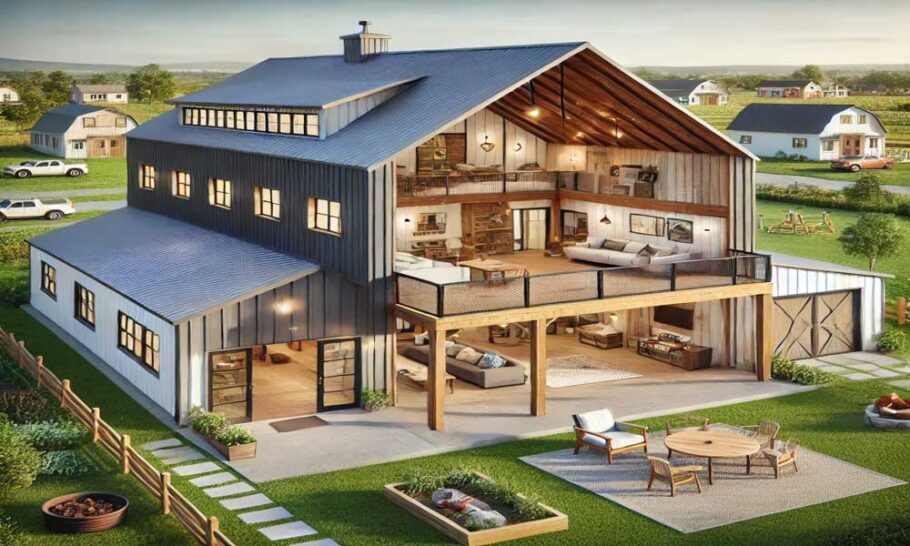When building a barndominium in a rural area, one of the least glamorous but most essential parts of your planning is the septic system. While people often get excited about floor plans, finishes, and exterior design, few realize that your wastewater disposal system can significantly impact both your comfort and your budget. Septic systems for barndominiums require thoughtful design—especially since many barndominiums are built on large, undeveloped lots where municipal sewer lines don’t reach.
In this comprehensive guide, we’ll explore everything you need to know about barndominium septic systems—from soil testing and site placement to system types and maintenance tips.
Why Barndominiums in Rural Areas Need Septic Systems
Most barndominiums are built in rural or semi-rural settings, far from city infrastructure. These areas often lack municipal sewer hookups, which means homeowners must handle their own wastewater treatment on-site. A septic system provides a safe and efficient way to do this by collecting, treating, and dispersing wastewater into the soil.
The system essentially mimics a small-scale municipal treatment plant right in your backyard—relying on natural processes and soil filtration to safely return treated water to the environment.
The Core Components of a Barndominium Septic System
Before designing a system, it’s helpful to understand how it works. A standard septic system includes several interconnected parts:
- The Septic Tank – This buried, watertight tank (typically made of concrete, fiberglass, or polyethylene) holds wastewater from your barndominium. Solids settle to the bottom, forming sludge, while lighter materials like grease float to the top as scum.
- The Distribution Box (D-Box) – The D-box evenly directs the partially treated liquid (effluent) from the tank to the drain field pipes.
- The Drain Field (Leach Field) – A series of perforated pipes or chambers buried in gravel-filled trenches. The effluent percolates into the soil, where microbes further purify it.
- The Soil – The unsung hero of your septic system. The right type and depth of soil is crucial for proper filtration and absorption.
Step 1: Conduct a Percolation Test (Perc Test)
A perc test (short for percolation test) is the first critical step in designing your barndominium septic system. It measures how quickly water drains through the soil—a key factor in determining whether your land can support a conventional system.
A licensed professional or engineer typically digs several holes on your lot and fills them with water. They then observe how long it takes for the water level to drop.
- Sandy soil drains too quickly, meaning wastewater might not get fully treated.
- Clay soil drains too slowly, risking backups and standing water.
- Loam soil usually provides the best balance of drainage and treatment.
If your land fails a perc test, don’t panic. Alternative systems (like mound or aerobic systems) can often be used instead.
Step 2: Plan System Size and Capacity
The size of your septic system depends primarily on the number of bedrooms in your barndominium, not just square footage. Building codes use bedrooms as a proxy for potential occupants—and therefore, wastewater output.
Typical guidelines:
- 1–2 bedrooms: 750–1,000-gallon tank
- 3–4 bedrooms: 1,000–1,500-gallon tank
- 5+ bedrooms: 1,500–2,000-gallon tank
However, lifestyle factors also matter. If your barndominium includes:
- A large soaking tub or hot tub
- A home-based business (like a beauty salon or small commercial kitchen)
- Multiple laundry facilities
You may need a larger system or additional treatment capacity.
Step 3: Choose the Right Type of Septic System
Different sites and soil conditions call for different septic system designs. Here are the most common options for rural barndominiums:
- Conventional Gravity System
The simplest and most affordable design—ideal for flat or gently sloping lots with good soil percolation. Wastewater flows by gravity from the barndominium to the tank, then to the drain field.
Pros: Low maintenance, cost-effective.
Cons: Requires suitable soil and slope; not ideal for high groundwater or rocky terrain.
- Pressure Distribution System
This system uses a pump to evenly distribute effluent across the drain field, ensuring better treatment and longer soil life.
Pros: Great for uneven or shallow sites.
Cons: Higher maintenance due to mechanical parts.
- Mound System
Used where the natural soil is too shallow or impermeable. A mound of sand and gravel is built to elevate the drain field above the native soil.
Pros: Works on challenging lots with poor soil.
Cons: More visible, requires regular maintenance, and can be costly to install.
- Aerobic Treatment Unit (ATU)
Similar to a small wastewater treatment plant, an ATU injects air into the tank to promote bacterial breakdown of waste.
Pros: Produces cleaner effluent; works on nearly any site.
Cons: Expensive installation and ongoing power use.
Step 4: Site Placement and Layout Considerations
Placement is crucial—not just for performance but also for long-term maintenance and aesthetics.
Key placement tips:
- Stay uphill from wells and water sources. Your septic system should be at least 100 feet away from any wells.
- Keep distance from foundations. Maintain a 10–20 foot buffer from your barndominium to avoid structural issues.
- Avoid flood-prone areas. Drain fields don’t function properly in saturated soil.
- Leave access for maintenance. The tank should be reachable for pumping trucks.
- Consider landscaping. Avoid planting trees near drain lines; their roots can cause damage.
A good site layout integrates your septic system seamlessly with your overall barndominium plan—so it doesn’t interfere with driveways, patios, or future expansion.
Step 5: Permits, Inspections, and Local Regulations
Septic systems are heavily regulated to protect groundwater and public health. Before construction, you’ll need to:
- Submit a site plan and soil test results to your county’s environmental health department.
- Obtain a septic permit or onsite wastewater permit.
- Have your installation inspected—often both before and after backfilling.
Some areas require engineered systems designed by a licensed professional. Your barndominium builder or general contractor should coordinate with local authorities early in the process to avoid costly delays.
Step 6: Maintenance and Longevity
Once your system is installed, proper maintenance ensures it lasts for decades. A well-designed, well-maintained septic system can function for 25–40 years or more.
Essential maintenance tips:
- Pump the tank every 3–5 years (depending on use and tank size).
- Avoid overloading the system—spread out laundry loads, fix leaky toilets, and use water-efficient fixtures.
- Do not use harsh chemicals or antibacterial soaps that can kill beneficial bacteria.
- Keep records of installation, pumping, and inspections.
- Monitor your drain field—wet spots or odors can indicate issues.
Regular attention prevents costly failures that could contaminate groundwater or require full system replacement.
Special Considerations for Barndominiums
Because barndominiums often feature open layouts, large kitchens, and workshop spaces, they may produce a different wastewater profile than a traditional home.
Some things to consider:
- Floor drains in shop areas should be carefully managed—never connect them to your residential septic system if they collect grease, oil, or chemicals.
- Accessory dwellings or guest suites may require additional tank capacity or separate systems.
- Seasonal occupancy (if used as a vacation home) can affect bacterial balance in the tank; periodic maintenance may be needed even when usage is low.
Cost Overview
The cost of a septic system varies widely depending on soil conditions, system type, and local labor rates.
Typical estimates:
- Conventional system: $4,000–$8,000
- Pressure system: $7,000–$12,000
- Mound system: $10,000–$20,000
- Aerobic system: $12,000–$25,000
Always include these costs early in your barndominium budget, along with excavation and permitting fees.
Eco-Friendly and Advanced Options
For those looking to minimize environmental impact, consider:
- Greywater reuse systems for irrigation.
- Composting toilets to reduce tank load.
- Drip dispersal systems that slowly release treated effluent under landscaping.
- Advanced treatment units that further purify wastewater before release.
These systems can reduce strain on your soil and groundwater while extending the life of your septic system.
Final Thoughts: Integrating the Invisible System
Your barndominium’s septic system might not be visible like your exterior siding or vaulted ceilings, but it’s one of the most critical parts of your home’s infrastructure. When designed properly, it works silently and efficiently for decades—protecting your health, your property value, and your environment.
A well-planned septic system should be treated as an integral part of your overall barndominium design strategy—not an afterthought. From initial soil testing to long-term maintenance, investing time and care in this hidden system ensures your rural barndominium remains comfortable, compliant, and sustainable for years to come.

